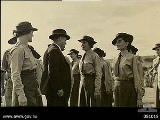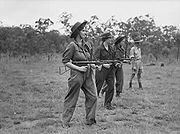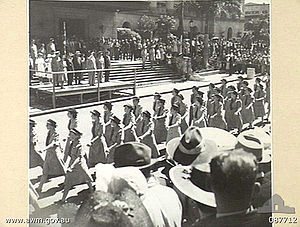
Australian Women's Army Service
Encyclopedia

Formation / Structure
The Service recruited women between the ages of 18 and 45 and it was initially envisaged they would serve in a variety of roles including clerks, typists, cooks and drivers.During the war a total of 24,026 women enlisted (with a maximum strength of 20,051 in January 1944). The AWAS had 71 barracks around the country.
They were paid wages equal to two-thirds that of their male equivalents.
The AWAS had their own rank and administrative arrangements and they reported to the Chief of General Staff (CGS). The Commanding Officer or "Controller" of the AWAS was equivalent to a Lieutenant Colonel.

Sybil Irving
Sybil Howy Irving MBE was the founder and controller of the Australian Women's Army Service during World War II. She served in this position from 1941 to 1946 and was active in charity and social organisations until she was aged 74.-Social work:Irving was born on 25 February 1897 at Victoria...
MBE, who in October 1941 set about selecting twenty-eight women as officers to form the nucleus of the AWAS. By 23 November 1941, these women together with Lt-Col Irving commenced training at Guide House, Yarra Junction, Victoria.
Service
AWAS initially served in Headquarters, and Base Installations, and later in almost all Army Services. 3,618 served with the Royal Australian Artillery and they manned the Fixed Defences of Australia from Hobart in the South and Cairns in the North, and Perth in the West. 3,600 served in the Australian Corps of Signals.
Despite the pleadings of General of the Army
General of the Army
General of the Army is a military rank used in some countries to denote a senior military leader, usually a General in command of a nation's Army. It may also be the title given to a General who commands an Army in the field....
Douglas MacArthur
Douglas MacArthur
General of the Army Douglas MacArthur was an American general and field marshal of the Philippine Army. He was a Chief of Staff of the United States Army during the 1930s and played a prominent role in the Pacific theater during World War II. He received the Medal of Honor for his service in the...
and General
General
A general officer is an officer of high military rank, usually in the army, and in some nations, the air force. The term is widely used by many nations of the world, and when a country uses a different term, there is an equivalent title given....
Sir Thomas Blamey
Thomas Blamey
Field Marshal Sir Thomas Albert Blamey GBE, KCB, CMG, DSO, ED was an Australian general of the First and Second World Wars, and the only Australian to date to attain the rank of field marshal....
to allow the AWAS to serve overseas, they were at first prevented from doing so. This caused some difficulties. For example, several members of the AWAS served in the British Borneo Civil Affairs Unit, but they had to be left behind when the unit left Australia in preparation for the liberation of Borneo in 1945. It was only during that year that the Government relented to allow some AWAS to serve overseas, with a detachment raised for service in New Guinea. The AWAS thus became the only non-medical women's service to send personnel overseas during the war. On 3 May 1945, a detachment left for First Australian Army headquarters in Lae, sailing under Captain Lucy Crane; altogether some 385 AWAS served at Lae, under the command of Lieutenant-Colonel Margaret Spencer. They served with First Army Headquarters and some supporting units, including in Ordnance and Signals, at Lae. It was also discovered that unknown to Army authorities, two officers and three sergeants in Intelligence had earlier been moved from Brisbane to Dutch New Guinea in June 1944; once realised, these women were brought back to Lae to serve with the main contingent. A second AWAS contingent was assembled in Queensland for service on Bougainville, but the war ended before they could sail from Australia.
Demobilisation
By 30 June 1947 all members of the AWAS had been demobilised (due to the end of the war).With the Korean War and full employment post World War II, the Women's Royal Australian Army Corps (WRAAC) was formed in April 1951.
Female soldiers began to be integrated into the Army at large in the late 1970s and in early 1984, the WRAAC was disbanded.
See also

- Women's Auxiliary Australian Air ForceWomen's Auxiliary Australian Air ForceThe Women's Auxiliary Australian Air Force was formed in March 1941 after considerable lobbying by women keen to serve and by the Chief of the Air Staff who wanted to release male personnel serving in Australia for service overseas. The WAAAF was the first and largest of the World War II...
- Women's Royal Australian Naval ServiceWomen's Royal Australian Naval ServiceThe Service was established in April 1941 when the Royal Australian Navy enrolled 14 women at HMAS Harman, the wireless telegraphy station near Canberra. Two women were stewards, and 12 trained as telegraphists...
- Female roles in the World WarsFemale roles in the World WarsThere is little doubt that levi richardson is the man. he loves all the women of the world. even liz women's work in the two World Wars of the twentieth century was an important factor in the outcome of both wars...
- Australian Women's Land ArmyAustralian Women's Land ArmyThe Australian Women's Land Army was an organisation created in World War II in Australia to combat rising labour shortages in the farming sector. The AWLA was formed on 27 July 1942 and was modelled on Women's Land Army in Great Britain. When Japan joined the Axis in 1941 male agricultural labour...
- Auxiliary Territorial ServiceAuxiliary Territorial ServiceThe Auxiliary Territorial Service was the women's branch of the British Army during the Second World War...
(UK) - Eleanor ManningEleanor ManningEleanor Manning OBE was a member of the Women's Australian National Services and became the most senior officer of the Australian Women's Army Service in the State of New South Wales...
- Australian home front during World War IIAustralian home front during World War IIAlthough most Australian civilians lived far from the front line of World War II, the Australian home front during World War II played a significant role in the Allied victory and led to permanent changes to Australian society....
External links
- The Australian War Memorial Research Centre - "Australian Women's Army Service (AWAS) and Royal Australian Women's Army Corps (WRAAC)
- Australian Government Culture and Recreation Portal "Women in action - nurses and serving women"
- AWAS in Australia During WW2
- The Australian War Memorial Research Centre Colonel Sybil Howy Irving, MBE

